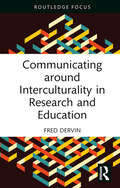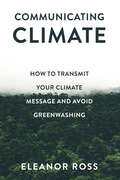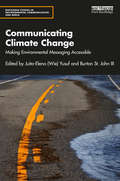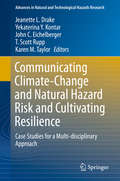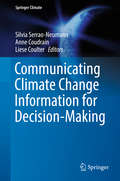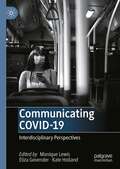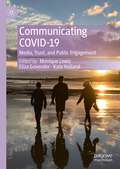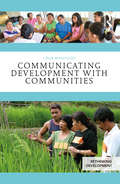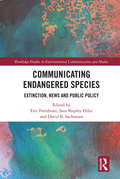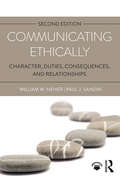- Table View
- List View
Communicating around Interculturality in Research and Education (New Perspectives on Teaching Interculturality)
by Fred DervinThis book does not instruct the reader how to communicate interculturally but supports them in reflecting on how they can (re-)negotiate and (re-)construct knowledge(s), ideologies and relations around the notion of interculturality. Anchored in the author’s original and thought-provoking perspectives on interculturality, this interdisciplinary and global-minded book explores how communicating around the notion cannot do away with ideologisms, issues of language and translation or the problematization of voice and silence in research and education. Written in an original and stimulating way, relying on different writing genres and styles to ‘mimic’ the dynamism and flexibility of the very notion under review, the author urges us to (un-)voice, scrutinize, nurture and galvanize our ways of dealing with interculturality alone and together with others in academia. The very specific focus of the book, communicating around interculturality (instead of ‘doing’ interculturality), represents a fresh and important move for observing, analyzing, speaking of and contributing to today's complex and divided world. The title is aimed at researchers, students and educators interested in examining and enriching their own takes on interculturality, from a more reflexive and interactive perspective.
Communicating at the End of Life: Finding Magic in the Mundane (LEA's Series on Personal Relationships)
by Elissa FosterThis enlightening volume provides first-hand perspectives and ethnographic research on communication at the end of life, a topic that has gone largely understudied in communication literature. Author Elissa Foster’s own experiences as a volunteer hospice caregiver form the basis of the book. Communicating at the End of Life recounts the stories of Foster and six other volunteers and their communicative experiences with dying patients, using communication theory and research findings to identify insights on the relationships they form throughout the process. What unfolds is a scholarly examination of a subject that is significant to every individual at some point in the life process. Organized chronologically to follow the course of Foster’s involvement with hospice and the phases of the study, the book opens with Part 1, providing background and contextual information to help readers understand subsequent stories about communication between volunteers and patients. Part 2 of the volume emphasizes the adjustments required by the volunteers as they entered the world of hospice and the worlds of the patients. Part 3 underscores the importance of improvisation and finding balance within the role of volunteer—in particular how to be fully present for patients as well as their family members. The volume concludes with Part 4, which addresses how volunteers coped with the death of their patients and what they learned from the experience of volunteering. Communicating at the End of Life is appropriate for scholars and advanced students studying personal relationships, health communication, gerontology, interpersonal communication, lifespan communication, and communication & aging. Its unique content offers precious and meaningful insights on the communication processes at a critical point in the life process.
Communicating at the End of Life: Finding Magic in the Mundane (LEA's Series on Personal Relationships)
by Elissa FosterThis enlightening volume provides first-hand perspectives and ethnographic research on communication at the end of life, a topic that has gone largely understudied in communication literature. Author Elissa Foster’s own experiences as a volunteer hospice caregiver form the basis of the book. Communicating at the End of Life recounts the stories of Foster and six other volunteers and their communicative experiences with dying patients, using communication theory and research findings to identify insights on the relationships they form throughout the process. What unfolds is a scholarly examination of a subject that is significant to every individual at some point in the life process. Organized chronologically to follow the course of Foster’s involvement with hospice and the phases of the study, the book opens with Part 1, providing background and contextual information to help readers understand subsequent stories about communication between volunteers and patients. Part 2 of the volume emphasizes the adjustments required by the volunteers as they entered the world of hospice and the worlds of the patients. Part 3 underscores the importance of improvisation and finding balance within the role of volunteer—in particular how to be fully present for patients as well as their family members. The volume concludes with Part 4, which addresses how volunteers coped with the death of their patients and what they learned from the experience of volunteering. Communicating at the End of Life is appropriate for scholars and advanced students studying personal relationships, health communication, gerontology, interpersonal communication, lifespan communication, and communication & aging. Its unique content offers precious and meaningful insights on the communication processes at a critical point in the life process.
Communicating Clearly about Science and Medicine: Making Data Presentations as Simple as Possible ... But No Simpler
by John ClareScientific communication is challenging. The subject matter is complex and often requires a certain level of knowledge to understand it correctly; describing hazard ratios, interpreting Kaplan Meier curves and explaining confounding factors is different from talking about a new car or clothing range. Processes, for example in clinical trials, are laborious and tedious and knowing how much of the detail to include and exclude requires judgement. Conclusions are rarely clear cut making communicating statistical risk and probability tough, especially to non-statisticians and non-scientists such as journalists. Communicating Clearly about Science and Medicine looks at these and many more challenges, then introduces powerful techniques for overcoming them. It will help you develop and deliver impactful presentations on medical and scientific data and tell a clear, compelling story based on your research findings. It will show you how to develop clear messages and themes, while adhering to the advice attributed to Einstein: 'Make things as simple as possible...but no simpler.' John Clare illustrates how to communicate clearly the risks and benefits contained in a complex data set, and balance the hope and the hype. He explains how to avoid the 'miracle cure' or 'killer drug' headlines which are so common and teaches you how to combine the accuracy of peer-to-peer reviewed science with the narrative skills of journalism.
Communicating Clearly about Science and Medicine: Making Data Presentations as Simple as Possible ... But No Simpler
by John ClareScientific communication is challenging. The subject matter is complex and often requires a certain level of knowledge to understand it correctly; describing hazard ratios, interpreting Kaplan Meier curves and explaining confounding factors is different from talking about a new car or clothing range. Processes, for example in clinical trials, are laborious and tedious and knowing how much of the detail to include and exclude requires judgement. Conclusions are rarely clear cut making communicating statistical risk and probability tough, especially to non-statisticians and non-scientists such as journalists. Communicating Clearly about Science and Medicine looks at these and many more challenges, then introduces powerful techniques for overcoming them. It will help you develop and deliver impactful presentations on medical and scientific data and tell a clear, compelling story based on your research findings. It will show you how to develop clear messages and themes, while adhering to the advice attributed to Einstein: 'Make things as simple as possible...but no simpler.' John Clare illustrates how to communicate clearly the risks and benefits contained in a complex data set, and balance the hope and the hype. He explains how to avoid the 'miracle cure' or 'killer drug' headlines which are so common and teaches you how to combine the accuracy of peer-to-peer reviewed science with the narrative skills of journalism.
Communicating Climate: How to Transmit Your Climate Message and Avoid Greenwashing
by Eleanor RossBusinesses can no longer afford to stick their heads in the sand. The time to act is now. Cities are becoming unliveable, triggering migration patterns and resource shortages, in turn causing civil wars and conflict. Natural disasters like hurricanes and wildfires are simply becoming known as ‘weather’, and biodiversity is disappearing from our very eyes. The fact is, we won’t have a planet to do business on if we don’t act now. Climate change is already hitting our bottom lines, as the cost of natural resources, energy, and manpower skyrocket. It’s predicted to cost the world $20 trillion a year if we can’t keep global heating to less than 2 degrees Celsius. This is a book about communicating climate: how to achieve cut-through, whether you’re trying to inspire your clients, get your shareholders on board, or simply showcase your progress in greening the world. This is not a greenwashing manual. It is about achieving balance in a world where we need to reduce our consumption, but also keep businesses functioning, just in a cleaner, greener, way. Communicating Climate is packed with case studies, examples, tips and interviews from those leading the charge towards sustainability.
Communicating Climate: How to Transmit Your Climate Message and Avoid Greenwashing
by Eleanor RossBusinesses can no longer afford to stick their heads in the sand. The time to act is now. Cities are becoming unliveable, triggering migration patterns and resource shortages, in turn causing civil wars and conflict. Natural disasters like hurricanes and wildfires are simply becoming known as ‘weather’, and biodiversity is disappearing from our very eyes. The fact is, we won’t have a planet to do business on if we don’t act now. Climate change is already hitting our bottom lines, as the cost of natural resources, energy, and manpower skyrocket. It’s predicted to cost the world $20 trillion a year if we can’t keep global heating to less than 2 degrees Celsius. This is a book about communicating climate: how to achieve cut-through, whether you’re trying to inspire your clients, get your shareholders on board, or simply showcase your progress in greening the world. This is not a greenwashing manual. It is about achieving balance in a world where we need to reduce our consumption, but also keep businesses functioning, just in a cleaner, greener, way. Communicating Climate is packed with case studies, examples, tips and interviews from those leading the charge towards sustainability.
Communicating Climate Change: Making Environmental Messaging Accessible (Routledge Studies in Environmental Communication and Media)
by Juita-Elena Wie Yusuf And Burton St. John IIIThis edited collection focuses on theoretical and applied research-based observations concerning how experts, advocates, and institutions make climate change information accessible to different audiences. Communicating Climate Change concentrates on three key elements of climate change communication – access, relevance, and understandability – to provide an overview of how these aspects allow multiple groups of stakeholders to act on climate-related information to build resilience. Featuring contributions from a wide range of scholars from across different disciplines, this book explores a multitude of different scenarios and communication methods, including social media; public opinion surveys; participatory mapping; and video. Overall, climate change communication is addressed from three different perspectives: communicating with the public; communicating for stakeholder engagement; and organizational, institutional, risk, and disaster communication. With each chapter focusing on implications and applications for practice, this book will be of great interest to students and researchers of climate change and environmental communication, as well as practitioners interested in understanding how to better engage stakeholders through climate change-related communication.
Communicating Climate Change: The Path Forward (Palgrave Studies in Media and Environmental Communication)
by Susanna PriestThis book asks and answers the question of what communication research and other social sciences can offer that will help the global community to address climate change by identifying the conditions that can persuade audiences and encourage collective action on climate. While scientists often expect that teaching people the scientific facts will change their minds about climate change, closer analysis suggests this is not always the case. Communication scholars are pursuing other ideas based on what we know about influence and persuasion, but this approach does not provide complete answers either. Some misconceptions can be corrected by education, and some messages will be more powerful than others. The advent of the Internet also makes vast stores of information readily available. But audiences still process this information through different filters, based on their own values and beliefs – including their understanding of how science works. In between momentous events, media coverage of climate tends to recede and individuals turn their attention back to their daily lives. Yet there is a path forward: Climate change is a social justice issue that no individual – and no nation – can solve on their own. A different sort of communication effort can help.
Communicating Climate Change: Making Environmental Messaging Accessible (Routledge Studies in Environmental Communication and Media)
by Juita-Elena Wie Yusuf Burton St. John IIIThis edited collection focuses on theoretical and applied research-based observations concerning how experts, advocates, and institutions make climate change information accessible to different audiences. Communicating Climate Change concentrates on three key elements of climate change communication – access, relevance, and understandability – to provide an overview of how these aspects allow multiple groups of stakeholders to act on climate-related information to build resilience. Featuring contributions from a wide range of scholars from across different disciplines, this book explores a multitude of different scenarios and communication methods, including social media; public opinion surveys; participatory mapping; and video. Overall, climate change communication is addressed from three different perspectives: communicating with the public; communicating for stakeholder engagement; and organizational, institutional, risk, and disaster communication. With each chapter focusing on implications and applications for practice, this book will be of great interest to students and researchers of climate change and environmental communication, as well as practitioners interested in understanding how to better engage stakeholders through climate change-related communication.
Communicating Climate-Change and Natural Hazard Risk and Cultivating Resilience: Case Studies for a Multi-disciplinary Approach (Advances in Natural and Technological Hazards Research #45)
by Jeanette L. Drake Yekaterina Y. Kontar John C. Eichelberger T. Scott Rupp Karen M. TaylorThis edited volume emphasizes risk and crisis communication principles and practices within the up-to the minute context of new technologies, a new focus on resiliency, and global environmental change. It includes contributions from experts from around the globe whose research, advocacy, teaching, work, or service in the natural or social sciences deals with risk communication and/or management surrounding natural and technological disasters, with a particular focus on climate change-related phenomena. Resilience and good communication are intimately linked and with climate change precipitating more numerous and onerous weather-related catastrophes, a conversation on resilience is timely and necessary. The goal is robust communities that are able to withstand the shock of disaster. Communicating well under ordinary circumstances is challenging; communicating during a crisis is extraordinarily difficult.This book is dedicated to all those who have directly or indirectly suffered the effects of climate change end extreme events with the hope that the advance of knowledge, implementation of sound science and appropriate policies and use of effective communication will help in reducing their vulnerability while also improving resilience in the face of often devastating natural and technological disasters.
Communicating Climate Change in China: A Dynamic Discourse Approach
by Sidan WangThis book explores how China's media narrate climate policy and climate change. With the rapid growth of economy and carbon emissions, China has been seen as having a key role in addressingclimate change and receives substantial attention from the media. In theChinese coverage, climate change issues can be interpreted as various concernsand ideas involving the dimensions of the economy, energy and emissions, publicinvolvement, science and ecology, and responsibility. In this sense, a discourseapproach can be used to understand how the newspapers construct the climatechange discourse and discourse networks in the coverage. This study selectsthree different newspapers in China, namely People’sDaily, China Daily and Southern Weekend. This book will interest scholars of Chinese politics, environmentalists, and media studies scholars.
Communicating Climate Change Information for Decision-Making (Springer Climate)
by Silvia Serrao-Neumann Anne Coudrain Liese CoulterThis book provides important insight on a range of issues focused on three themes; what new climate change information is being developed, how that knowledge is communicated and how it can be usefully applied across international, regional and local scales. There is increasing international investment and interest to develop and communicate updated climate change information to promote effective action. As change accelerates and planetary boundaries are crossed this information becomes particularly relevant to guide decisions and support both proactive adaptation and mitigation strategies. Developing new information addresses innovations in producing interdisciplinary climate change knowledge and overcoming issues of data quality, access and availability. This book examines effective information systems to guide decision-making for immediate and future action. Cases studies in developed and developing countries illustrate how climate change information promotes immediate and future actions across a range of sectors.
Communicating COVID-19: Interdisciplinary Perspectives
by Kate Holland Monique Lewis Eliza GovenderThis book explores communication during the first year of the COVID-19 pandemic. Featuring the work of leading communication scholars from around the world, it offers insights and analyses into how individuals, organisations, communities, and nations have grappled with understanding and responding to the pandemic that has rocked the world. The book examines the role of journalists and news media in constructing meanings about the pandemic, with chapters focusing on public interest journalism, health workers and imagined audiences in COVID-19 news. It considers public health responses in different countries, with chapters examining community-driven approaches, communication strategies of governments and political leaders, public health advocacy, and pandemic inequalities. The role of digital media and technology is also unravelled, including social media sharing of misinformation and memetic humour, crowdsourcing initiatives, the use of data in modelling, tracking and tracing, and strategies for managing uncertainties created in a pandemic.
Communicating COVID-19: Media, Trust, and Public Engagement
by Monique Lewis Eliza Govender Kate HollandThis edited collection, follows on from 'Communicating COVID-19: Interdisciplinary Perspectives' (2021) and brings together different scholars from around the world to explore and critique the ongoing advances of communicating COVID, two years into the pandemic. Pandemic life has become familiar to us, with all its disruptions and uncertainties. In the second year of COVID, many societies emerged well attuned to new waves of infections, while others, having initially demonstrated 'gold standard' responses, regressed, either through a premature end to public health restrictions or challenges around vaccine rollouts. In many countries, bitter social divisions have arisen over mask-wearing, lockdowns, quarantine and vaccination. To better understand the ever evolving communicative landscape of COVID-19, this collection shares updated perspectives from the disciplines of media and communication, journalism, public health and primary care, sociology, and political and behavioural science, addressing the major issues that have confronted communicators, including vaccine hesitancy, misinformation, and the mobilisation of community driven communication responses as restrictions eased in various parts of the world.
Communicating Creativity: The Discursive Facilitation of Creative Activity in Arts (Communicating in Professions and Organizations)
by Darryl HockingThis book provides an extensive and original analysis of the way that written and spoken communication facilitates creative practice in the university art and design studio. Challenging the established view of creativity as a personal attribute which can be objectively measured, the author demonstrates instead that creativity and creative practice are constructed through a complex array of intersecting discourses, each shaped by wider socio-historical contexts, beliefs and values. The author draws upon a range of methods and resources to capture this dynamic complexity from corpus linguistics to ethnography and multimodal analysis. This innovative volume will appeal to students and scholars of discourse analysis, creativity, and applied linguistics. It will also appeal to art and design educators.
Communicating Development with Communities (Rethinking Development)
by Linje ManyozoDevelopment theory and practice are often taught in a manner that strips them of their historical context and obscures alternative intellectual assumptions and critical frameworks. This prevents students from acquiring a holistic understanding of the world and consequently, when it comes to development practice, most lack the skills to live and engage with people. It has become crucial to properly consider what it means to conceive and implement participatory development out in the field and not just in the boardroom. Building on the work of Robert Chambers and Arturo Escobar, Communicating Development with Communities is an empirically grounded critical reflection on how the development industry defines, imagines and constructs development at the implementation level. Unpacking the dominant syntax in the theory and practice of development, the book advocates a move towards relational and indigenous models of living that celebrate local ontologies, spirituality, economies of solidarity and community-ness. It investigates how subaltern voices are produced and appropriated, and how well-meaning experts can easily become oppressors. The book propounds a pedagogy of listening as a pathway that offers a space for interest groups to collaboratively curate meaningful development with and alongside communities. This is a valuable resource for academics and practitioners in the fields of Development Studies, Communication for Development, Communication for Social Change, Social Anthropology, Economic Development and Public Policy. Foreword by Robin Mansell.
Communicating Development with Communities (Rethinking Development)
by Linje ManyozoDevelopment theory and practice are often taught in a manner that strips them of their historical context and obscures alternative intellectual assumptions and critical frameworks. This prevents students from acquiring a holistic understanding of the world and consequently, when it comes to development practice, most lack the skills to live and engage with people. It has become crucial to properly consider what it means to conceive and implement participatory development out in the field and not just in the boardroom. Building on the work of Robert Chambers and Arturo Escobar, Communicating Development with Communities is an empirically grounded critical reflection on how the development industry defines, imagines and constructs development at the implementation level. Unpacking the dominant syntax in the theory and practice of development, the book advocates a move towards relational and indigenous models of living that celebrate local ontologies, spirituality, economies of solidarity and community-ness. It investigates how subaltern voices are produced and appropriated, and how well-meaning experts can easily become oppressors. The book propounds a pedagogy of listening as a pathway that offers a space for interest groups to collaboratively curate meaningful development with and alongside communities. This is a valuable resource for academics and practitioners in the fields of Development Studies, Communication for Development, Communication for Social Change, Social Anthropology, Economic Development and Public Policy. Foreword by Robin Mansell.
Communicating Effectively For Dummies (For Dummies Ser.)
by Marty BrounsteinCommunicating Effectively For Dummies shows you how to get your point across at work and interact most productively with bosses and coworkers. Applying your knowledge and skill to your job is the easy part; working well with others is often the hard part. This helpful guide lets you maximize your personal interactions, even when resolving conflicts, dealing with customers, or giving difficult presentations. Whether you’re the CEO of a major corporation, a small business owner, or a team manager, effective and clear communication is imperative to your success. From keeping your listener engaged to learning to become a better listener, Communicating Effectively For Dummies offers all the strategies, tips, and advice you need to: Learn how to become an active listener Accentuate the positive in negative situations Find win-win solutions for conflicts Stay on track when writing e-mails and letters Handle presentations, interviews, and other challenges Speak forcefully and assertively without alienating others Management consultant Marty Brounstein — author of Handling the Difficult Employee and Coaching and Mentoring For Dummies — gives you the keys to a thriving career with expert advice on effective verbal and nonverbal communication. From mastering your own facial expressions (and reading them in others) to being a happy boss, Brounstein covers all the angles: Becoming aware of your own assumptions Dealing with passive-aggressive communicators What to say to help someone open up to you Communicating through eye contact and body language Maintaining a positive attitude Dealing with sensitive issues Effective conflict resolution models When to use e-mail, the phone, or a face-to-face meeting Dealing with angry customers Coaching your staff to communicate better In today’s high-stress work environment, good communication skills are imperative for keeping your cool and getting your point across. Knowing what to say and how to say it, as well as being a good listener, can often be the difference between getting ahead and just getting by. This handy, friendly guide shows you how to avoid common conflicts and make your voice heard in the office.
Communicating Effectively in the Workforce (AICPA)
by Lisa PolackIf you do not understand how communication works, then you may become perplexed and frustrated by interactions in the workplace. However, if you understand how communication works, then you have a good chance of diagnosing and fixing communication problems. Best of all, you can influence and motivate your employees, make better decisions, negotiate more effectively, build better work teams, and accomplish business objectives. This book discusses the various forms of communication.
Communicating Effectively in the Workforce (AICPA)
by Lisa PolackIf you do not understand how communication works, then you may become perplexed and frustrated by interactions in the workplace. However, if you understand how communication works, then you have a good chance of diagnosing and fixing communication problems. Best of all, you can influence and motivate your employees, make better decisions, negotiate more effectively, build better work teams, and accomplish business objectives. This book discusses the various forms of communication.
Communicating Endangered Species: Extinction, News and Public Policy (Routledge Studies in Environmental Communication and Media)
by Eric Freedman; Sara Shipley Hiles; David B. SachsmanCommunicating Endangered Species: Extinction, News, and Public Policy is a multidisciplinary environmental communication book that takes a distinctive approach by connecting how media and culture depict and explain endangered species with how policymakers and natural resource managers can or do respond to these challenges in practical terms. Extinction isn’t new. However, the pace of extinction is accelerating globally. The International Union for Conservation of Nature classifies more than 26,000 species as threatened. The causes are many, including climate change, overdevelopment, human exploitation, disease, overhunting, habitat destruction, and predators. The willingness and the ability of ordinary people, governments, scientists, nongovernmental organizations, and businesses to slow this deeply disturbing acceleration are uncertain. Meanwhile, researchers around the world are laboring to better understand and communicate the possibility and implications of extinctions and to discover effective tools and public policies to combat the threats to species survival. This book presents a history of news coverage of endangered species around the world, examining how and why journalists and other communicators wrote what they did, how attitudes have changed, and why they have changed. It draws on the latest research by chapter authors who are a mix of social scientists, communication experts, and natural scientists. Each chapter includes a mass media and/or cultural aspect. This book will be essential reading for students, natural resource managers, government officials, environmental activists, and academics interested in conservation and biodiversity, environmental communication and journalism, and public policy.
Communicating Endangered Species: Extinction, News and Public Policy (Routledge Studies in Environmental Communication and Media)
by Eric Freedman Sara Shipley Hiles David B. SachsmanCommunicating Endangered Species: Extinction, News, and Public Policy is a multidisciplinary environmental communication book that takes a distinctive approach by connecting how media and culture depict and explain endangered species with how policymakers and natural resource managers can or do respond to these challenges in practical terms. Extinction isn’t new. However, the pace of extinction is accelerating globally. The International Union for Conservation of Nature classifies more than 26,000 species as threatened. The causes are many, including climate change, overdevelopment, human exploitation, disease, overhunting, habitat destruction, and predators. The willingness and the ability of ordinary people, governments, scientists, nongovernmental organizations, and businesses to slow this deeply disturbing acceleration are uncertain. Meanwhile, researchers around the world are laboring to better understand and communicate the possibility and implications of extinctions and to discover effective tools and public policies to combat the threats to species survival. This book presents a history of news coverage of endangered species around the world, examining how and why journalists and other communicators wrote what they did, how attitudes have changed, and why they have changed. It draws on the latest research by chapter authors who are a mix of social scientists, communication experts, and natural scientists. Each chapter includes a mass media and/or cultural aspect. This book will be essential reading for students, natural resource managers, government officials, environmental activists, and academics interested in conservation and biodiversity, environmental communication and journalism, and public policy.
Communicating Ethically: Character, Duties, Consequences, and Relationships
by William Neher Paul SandinCommunicating Ethically provides a broad introduction to the ethical nature of communication. Now in its second edition, the text has been revised to further address current issues, such as: evolving social media and digital platforms, growing cultural communication and discussion of diversity, and the ethics of public discourse. This book combines coverage of the major systems of ethical reasoning with applications, including case studies in each chapter, to investigate ethics within many fields in the communication discipline. Incorporating a simple framework for ethical reasoning allows the reader to develop their own understanding of the various criteria for making ethical judgments.
Communicating Ethically: Character, Duties, Consequences, and Relationships
by William Neher Paul SandinCommunicating Ethically provides a broad introduction to the ethical nature of communication. Now in its second edition, the text has been revised to further address current issues, such as: evolving social media and digital platforms, growing cultural communication and discussion of diversity, and the ethics of public discourse. This book combines coverage of the major systems of ethical reasoning with applications, including case studies in each chapter, to investigate ethics within many fields in the communication discipline. Incorporating a simple framework for ethical reasoning allows the reader to develop their own understanding of the various criteria for making ethical judgments.
